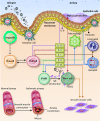Recent changes in the drug treatment of allergic asthma
- PMID: 24115705
- PMCID: PMC4953799
- DOI: 10.7861/clinmedicine.13-5-477
Recent changes in the drug treatment of allergic asthma
Abstract
Asthma is a heterogeneous condition with multiple phenotypes that respond to treatments in different ways. Allergic asthma is an important phenotype and although currently available treatments are effective, about 5% of affected patients have severe, treatment-refractory disease. Despite advances in our understanding of the disease, there remains an unmet need in this group of patients. The most recent and significant advance in treatment has been anti--immunoglobulin E (IgE) therapy, which improves symptoms and quality of life in patients with severe allergic asthma. Clinical trials are ongoing with novel biologic agents that demonstrate potential efficacy; determining the subsets of patients for which they are suitable will be crucial to ensure cost effectiveness. Personalised medicine and targeted therapies may hold the key to long-term control in this group of patients.
Keywords: Allergic asthma; Th2; phenotype; treatment.
Figures

References
-
- Asthma UK. Asthma facts and FAQs. www.asthma.org.uk/asthma-facts-and-statistics [Accessed 16 September 2013].
-
- Gibson J, Geddes D, Costabel U. et al. Respiratory medicine, 3rd ed. London: Saunders, 2003.
Publication types
MeSH terms
Substances
LinkOut - more resources
Full Text Sources
Other Literature Sources
Medical

